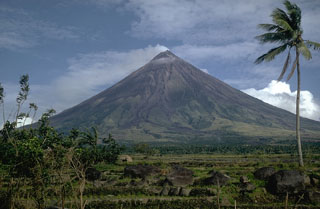Report on Mayon (Philippines) — May 2003
Bulletin of the Global Volcanism Network, vol. 28, no. 5 (May 2003)
Managing Editor: Edward Venzke.
Mayon (Philippines) Three small ash-and-steam explosions during April-May 2003
Please cite this report as:
Global Volcanism Program, 2003. Report on Mayon (Philippines) (Venzke, E., ed.). Bulletin of the Global Volcanism Network, 28:5. Smithsonian Institution. https://doi.org/10.5479/si.GVP.BGVN200305-273030
Mayon
Philippines
13.257°N, 123.685°E; summit elev. 2462 m
All times are local (unless otherwise noted)
The Philippine Institute of Volcanology and Seismology (PHIVOLCS) reported small ash and steam explosions from the Mayon volcano on 5 April, 6 May, and 14 May 2003. The alert status for the area around the volcano remained at Alert Level 1 on a scale of 0-5 (indicating an increased likelihood for steam-driven or ash explosions to occur with little or no warning). PHIVOLCS reminded the public to continue avoiding entry into the 6-km-radius Permanent Danger Zone (PDZ), especially in the sectors where life-threatening volcanic flows might be channeled by gullies.
Activity during April 2003. Following a small ash explosion on 17 March 2003 (BGVN 28:03), a brief burst of ash and steam occurred at about 0600 on 5 April. The ash column rose to ~1.5 km above the summit crater before being blown SW. The explosion was recorded as a low-frequency volcanic earthquake, signifying a shallow source. Prior to the explosion, the volcano's seismic network had detected three small low-frequency volcanic earthquakes and three low-frequency short-duration harmonic tremors in the past 24 hours. Electronic tiltmeters indicated continuing slight inflation of the edifice. The increases in activity strongly indicated the likelihood of sudden ash explosions. Although no major eruption was expected immediately after the explosion of 5 April, there was growing evidence that magma was ascending the volcano's conduit.
Activity during May 2003. A small explosion from the crater at 0721 on 6 May produced a brownish ash-and-steam column that rose to ~450 m above the summit crater and was blown SW. The ash-and-steam column rose slowly with minimal noticeable force and was not detected by the volcano's seismic network, indicating a very shallow source. No significant seismicity occurred prior to the explosion. However, electronic tiltmeters on the N and S flanks continued to show inflation. Likewise, a precise leveling survey on 24 April 2003 showed a general inflation of the N flank. Alert Level 1 remained in effect.
At 1813 on 14 May, a small ash puff was emitted from the summit crater. This very brief explosion caused a small volume of ash and steam to rise less than 100 m above the crater and to later be blown NW. The Mayon Resthouse and Sta Misericordia seismic stations recorded the ash puff as a small-amplitude event. Prior to the ash explosion, one short-duration tremor was recorded. Volcanic gas outputs were notably moderate in volume, and the sulfur dioxide emission rates increased from the previous 1,824 metric tons per day (t/d) to ~3,088 t/d. The seismic characteristics associated with the ash and steam emission appeared similar to, though smaller than, previous explosions since 22 October 2002, indicating that this ash puff was very minor. This assessment was also consistent with the smaller volume of ash produced.
Geological Summary. Symmetrical Mayon, which rises above the Albay Gulf NW of Legazpi City, is the most active volcano of the Philippines. The steep upper slopes are capped by a small summit crater. Recorded eruptions since 1616 CE range from Strombolian to basaltic Plinian, with cyclical activity beginning with basaltic eruptions, followed by longer periods of andesitic lava flows. Eruptions occur predominately from the central conduit and have also produced lava flows that travel far down the flanks. Pyroclastic density currents and mudflows have commonly swept down many of the approximately 40 ravines that radiate from the summit and have often damaged populated lowland areas. A violent eruption in 1814 killed more than 1,200 people and devastated several towns.
Information Contacts: Philippine Institute of Volcanology and Seismology (PHIVOLCS), Department of Science and Technology, PHIVOLCS Building, C.P. Garcia Avenue, University of the Philippines Campus, Diliman, Quezon City, Philippines (URL: http://www.phivolcs.dost. gov.ph/).

